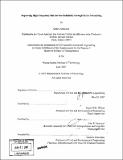Improving high-frequency bus service reliability through better scheduling
Author(s)
Fattouche, Grâce
DownloadFull printable version (13.85Mb)
Other Contributors
Massachusetts Institute of Technology. Dept. of Civil and Environmental Engineering.
Advisor
Nigel H.M. Wilson and John P. Attanucci.
Terms of use
Metadata
Show full item recordAbstract
Developing a schedule for high-frequency bus routes involves balancing the costs to the passengers in terms of passenger waiting time and in-vehicle time and the cost to the transit agency. Passengers are interested in short travel times and in short and reliable waiting times. In order to assess the trade-off between trip speed and reliability, transit planners need to follow a clear scheduling process; i.e., a series of steps the scheduler follows to create a schedule. This thesis develops a scheduling process based on a model which explicitly projects and evaluates the tradeoffs between overall travel time and reliability. The model uses Automatic Vehicle Location and Automatic Passenger Count data and is based on two critical hypotheses: (i) consecutive bus vehicle trips are independent and (ii) consecutive segment running times for a particular bus trips are independent. These two hypotheses will not be true in all cases but were shown to be true on the two CTA bus routes analyzed, 95E and 85. By simulating the running time distributions and headway variability of any proposed schedule, the model estimates the cost of the schedule for waiting passengers, onboard passengers and the transit agency. (cont.) The scheduling process involves finding the time point schedule which minimizes the total cost with the help of the model. The scheduling process is applied to two CTA bus routes; Route 95E and 85. For each route, the schedule which minimizes the total passenger cost was determined. The operating cost of the proposed schedule on each route is the same as for the current schedule because the same number of buses is used. The schedules obtained with the generalized cost minimization approach showed improved reliability and overall passenger service quality compared to the current schedule in both routes as well as compared to traditional approaches. A sensitivity analysis showed that in most cases the generalized cost minimization schedule can significantly improve reliability and overall passenger service quality over traditional approaches.
Description
Thesis (S.M.)--Massachusetts Institute of Technology, Dept. of Civil and Environmental Engineering, 2007. Includes bibliographical references (p. 134-135).
Date issued
2007Department
Massachusetts Institute of Technology. Department of Civil and Environmental EngineeringPublisher
Massachusetts Institute of Technology
Keywords
Civil and Environmental Engineering.